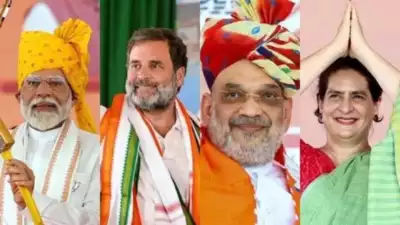
The culmination of a high-voltage campaign marked the final day of preparations ahead of the second phase of Lok Sabha elections, covering 89 seats across 13 states, including 1 seat in Jammu and Kashmir, scheduled for polling on April 26.
Campaign efforts, marked by rallies, roadshows, and public interactions, reached a crescendo as political parties made their last appeals to voters in key constituencies. The phase encompasses a diverse range of states, with significant electoral stakes in Kerala (all 20 seats), Karnataka (14 out of 28 seats), Rajasthan (13 seats), Maharashtra (8 seats), Uttar Pradesh (8 seats), Madhya Pradesh (7 seats), Assam (5 seats), Bihar (5 seats), Chhattisgarh (3 seats), West Bengal (3 seats), Manipur (1 seat), Tripura (1 seat), and Jammu and Kashmir (1 seat).
In the 5-Jammu Parliamentary Constituency, where polling is set to take place, over 17.80 lakh voters will decide among 22 candidates competing for this pivotal seat. This constituency encompasses 18 Assembly segments spread across four districts: Reasi, Samba, Jammu, and Rajouri.
Providing insights into the electoral landscape, the Returning Officer of 5-Jammu Parliamentary Constituency shared detailed statistics. The constituency boasts 17,80,835 registered voters, comprising 9,21,095 males, 8,59,712 females, and 28 transgender electors. Additionally, there are 37,822 service voters, including 37,025 males and 797 females.
To ensure seamless voting procedures, the Election Commission of India (ECI) has established 2416 polling stations across the constituency, strategically deploying resources such as 18 Green Polling Stations, 46 Pink Polling Stations, and 18 Polling Stations manned by Persons with Disabilities (PwD).
Each district within the constituency has unique demographics and preparations:
– Reasi district (comprising Gulabgarh, Reasi, Shri Mata Vaishno Devi Assembly Constituencies) houses 23,52,262 voters, including 1393 service voters, with 425 polling stations in place.
– Samba district (including Ramgrah, Samba, Vijaypur Assembly Constituencies) features 2,59,198 voters, including 10,269 service voters, and 365 polling stations.
– Jammu district (encompassing Bishnah, Suchetgarh, R S Pura-Jammu South, Bahu, Jammu East, Nagrota, Jammu West, Jammu North, Marh, Akhnoor, Chhamb Assembly Constituencies) boasts 11,89,389 electors, with 24,315 service voters, and 1488 polling stations.
– Rajouri district (Kalakote-Sunderbani Assembly Constituency) comprises 96,986 voters, including 1845 service voters, and 138 polling stations.
Of note, the R S Pura-Jammu South Assembly Constituency holds the distinction of having the highest voter count at 1,24,744, while the Shri Mata Vaishno Devi Assembly segment has the lowest at 55,737. The distribution of polling stations reflects a strategic approach to accommodate voter density and ensure efficient electoral processes.
As campaigning wraps up, the focus now shifts to the polling day, anticipated with keen interest as citizens exercise their democratic rights in the second phase of Lok Sabha elections across these significant constituencies.